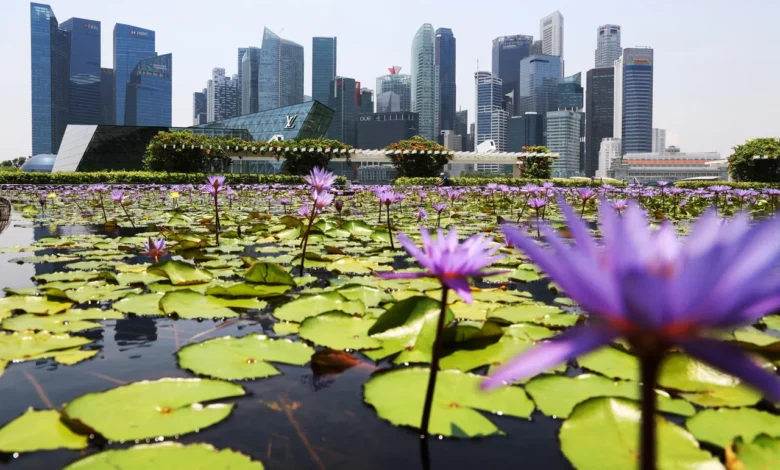Why Asean could be the decade’s best growth play

AS SOMEONE who has spent nearly 20 years in banking, I cannot recall a time that has filled me with as much optimism for Asean as the present – particularly when it comes to investment inflows.
The three reasons for my optimism lie in energy, infrastructure, and diversification.
The first is the energy play. Amid the global push for renewables and electric vehicles (EVs), what’s exciting is that Asean will be central to this effort.
Indonesia has large deposits of the raw materials necessary for the energy transition – including nickel and copper – as does the Philippines, which has reserves of nickel, copper and cobalt. This has already drawn significant inward investment, and will attract more.
Linked to this is the need to construct renewable energy infrastructure. Singapore is seeking a range of climate-ready investments, which is in line with our goal to meet nearly one-third of local energy needs by 2035 through importing low-carbon energy from our neighbours.
As a result, international firms have set up shop here to take part in Singapore’s, and later, Asean’s energy transition.
GET BT IN YOUR INBOX DAILY

Start and end each day with the latest news stories and analyses delivered straight to your inbox.
Broad-based foreign inflows
Next, the region is experiencing a broader infrastructure push. Indonesia is in the midst of building a new capital city after launching South-east Asia’s first high-speed rail link in 2023. Additionally, significant Asean-wide projects under discussion include a trans-Asean power grid to integrate members’ power systems, and help the region to decarbonise.
Finally, the China corridor. While some non-China companies are diversifying their manufacturing operations into Asean countries, we’ve also helped Chinese firms tap growth opportunities in the region. Among them are RMB internationalisation, sustainable finance, as well as supply chain diversification.
Testament to the strong interest among clients, our inbound cross-border network income from China to the region rose by double digits in 2023 from the previous year.
Also exciting is the intra-Asean export corridor: We forecast that by 2030 this will see annual export growth of 8.7 per cent, significantly surpassing the 5 per cent global average.
This means that Asean will continue to enjoy foreign direct investment disproportionately larger than one would otherwise expect, given its gross domestic product figure.
Additionally, these inflows will be broad-based: financial flows into Singapore; construction flows into Malaysia, Vietnam and Thailand; and other sums into Indonesia for the EV sector.
Overcoming challenges
While some observers might project another currency war leading to a new financial crisis, I believe that is unlikely – regional reserves are strong. The biggest risk to growth, in my view, is geopolitical tensions in Asia.
Aside from that, though, firms looking to enter Asean or expand in the region face more prosaic concerns about how best to navigate a 10-nation market of different laws and currencies, varying stages of development, and a range of languages and political systems.
Clients continue to want answers to questions such as: How can I minimise my forex risks? What’s the optimal capital structure for doing business in a particular Asean member? How can I find a reliable local law firm?
For these, clients need a partner with the experience and on-ground knowledge across the region – which is where Standard Chartered comes in.
We are the only international bank with a presence in all Asean markets, several of which have been for well over a century. Additionally, our country teams bring unparalleled knowledge of local laws, culture and the broader system, unique to that country.
They have also nurtured relationships in the public and private sectors, and can best navigate their country to our clients’ advantage. This domain knowledge ensures clients better understand where to invest, and how to grasp opportunities and pitfalls.
Driving a sustainable future: From technology to nature
There’s never been a better time to seize opportunities in Asean, especially as technology trends dramatically improve how business is done in the region.
Artificial intelligence will prove a game-changer as it is deployed more broadly, while digitalisation has already played a defining role in finance, including in cross-border payments and FX offerings.
Cash management is one area that has changed significantly. One example is pooling, where clients with cash in several Asean nations can optimise liquidity and yield without having to physically convert those funds. This minimises the need for clients to move cash around the region.
Another area of promise is blended finance. Singapore announced last year that it was looking to raise US$5 billion to finance projects, a move that will support the sustainability ambitions of Asean.
Blended finance works by bringing together public and private sources of capital to support projects that are deemed higher risk or may be more challenging for the private sector to finance by itself – for example, renewable energy grid infrastructure or climate adaptation projects such as planting mangrove forests.
Our support for such blended finance initiatives links directly to our profound commitment to sustainability, which we’ve underpinned with a US$300 billion pledge for sustainable financing.
However, that sum won’t fund everything that’s needed. As we approach the halfway point of the decade, one of the biggest questions then is how Asean will finance its transition. I believe one likely solution is to leverage its vast stock of natural capital to generate high-integrity carbon credits, perhaps through the region’s nascent carbon markets.
Bright future
From energy to infrastructure to investment corridors, there are numerous reasons to be optimistic for Asean and for its member nation Singapore, which has long been the gateway to the bloc and remains the location of choice for firms looking to set up regional headquarters.
Asean’s GDP, which was US$3.6 trillion in 2022, according to the 2024 Asean Statistical Brief, is projected to reach US$4.5 trillion by 2030 – likely positioning the bloc as the world’s leading growth prospect.
All this goes a long way as to why I’m so optimistic about its future, and why we at Standard Chartered are excited to help our clients and the region as we work together to navigate to a more sustainable world.
The author is Standard Chartered Bank’s head of client coverage, Singapore, Corporate & Investment Banking.


 Slots with Welcome Bonus Up to 400%
Slots with Welcome Bonus Up to 400%